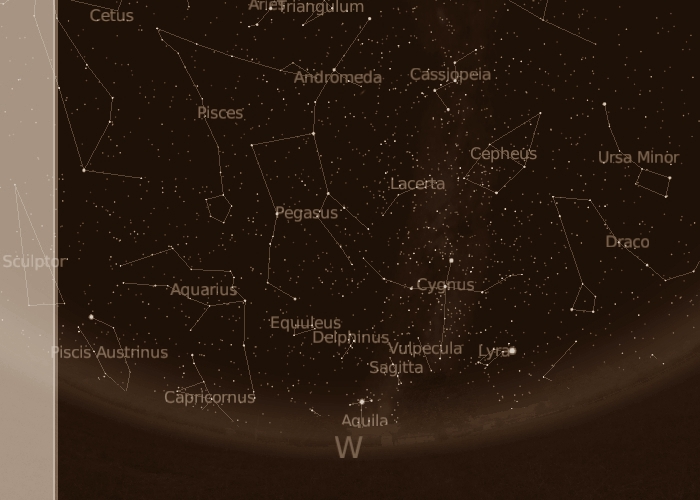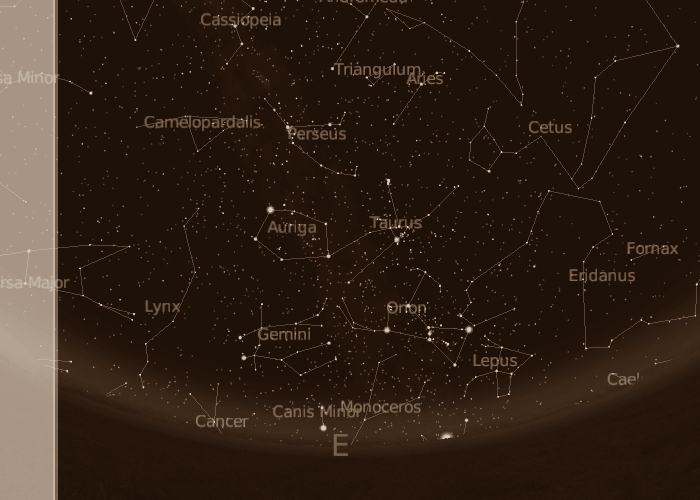Western Horizon
Eastern Horizon
Precisions About Daylight Saving Time (DST) Adjustments
->You will note that our site is back to Standard Time this month for the northern hemisphere. more details
![]()
Western Horizon
Eastern Horizon
Precisions About Daylight Saving Time (DST) Adjustments

The sky, in fall, has the remaining of the summer sky West and the rising winter constellations East. The Summer Triangle, now, is well low, about northwest. It might that a plain horizon is needed to catch the lowest spike of the triange, Altair that is. The Summer Triangle is the distinctive feature of the summer skies, as it's composed of the three main, bright stars of the constellations Cygnus, the Swan, Lyra, the Lyra and Aquila, the Eagle. As Vega, of Lyra is now tending low too, the only spike which is high still is Deneb, of Cygnus. Parts of Draco, the Dragon are seen northwest as Cepheus, Cepheus is high. Parts of Pegasus, the Winged Horse, are seen West, as Pegasus, along with all that part of the sky which were seen South the previous month, has now shifted West and southwest. Aquarius, the Water Bearer, is southwest, as the bright star you might catch under it is the famed Fomalhaut, the bright star to the southern constellation of Piscus Austrinis, the Southern Fish. Left of the Great Square of Pegasus, which is high, parts of Cetus, the Whale are seen, and the Circlet, this asterism which belongs to the constellation Pisces, the Fishes. Cetus, in its entirety, is well seen South. Mira, the famed, long-cycle variable, is, on the chart, situated between where Cetus anchors to Eridanus, the River Eridanus and the 'angle' made by the line of Fishes. For those who are found to have the Andromeda Galaxy at its best, there it is, about the zenith. The Andromeda Galaxy, or M31, on the chart, is the grey oval. to a printer-friendly chart
West for the tropics. West for the mid-southern latitudes

We're in November and it's a remarkable show, albeit some low for some of its parts, to see, East, all the great winter sky rising. Those constellations are going to keep on rising and eventually take their place, South, where they will be the distinctive feature of the winter sky. A fine and inspiring show! As Auriga, the Charioteer, with the bright Capella and Taurus, the Bull, with Aldebaran and the Hyades are now high, Gemini, the Twins and Orion, the Hunter are just the row below. Much fine views! Canis Minor, the Little Dog, and Canis Major, with the famed Sirius are still about unseen or not risen yet however. Another fine view is seen southeast, with Eridanus, the River Eridanus, this celestial river, taking its source at Rigel, and meandering its way towards the southern hemisphere. Perseus, Perseus, is high, above Auriga, as the faint Lynx is northeast, with Camelopardalis, the Giraffe, another faint constellation, high above it. A fine show is available too, North. There, with a plain horizon, you will see how Ursa Major, the Great Bear -the Great Dipper that is- is ending its grazing passage, like a circumpolar constellation, over the northern horizon, as Draco now is tending low, preparing in turn to pass over the horizon. The Little Dipper, with Polaris, is well seen too. to a printer-friendly chart
East for the tropics. East for the mid-southern latitudes
Most populated areas in the northern hemisphere -China excepted- are implementing Daylight Saving Time systems. According to the policy of our site, our sky charts include a one-hour DST shift for the period April to October. Should your DST period differ, just adjust the charts. Should you not have any DST, take in account that one-hour DST shift we are applying April-October
For more details upon whether you country is applying, and when, a DST, please check a search engine on the Internet, for example!
Website Manager: G. Guichard, site 'Amateur Astronomy,' http://stars5.6te.net. Page Editor: G. Guichard. last edited: 12/28/2010. contact us at ggwebsites@outlook.com